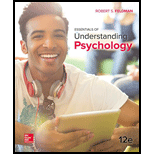
Introduction: The pattern of lasting, unique features that produces a consistency and individuality in a person is called personality. The personality leads a particular person to act consistently in various situations and over extended periods of time. Personality includes the behavior which makes every person unique and different from others. Trait theory, a personality approach, helps for the identification of basic traits that is needed to describe a personality.
Answer to Problem 1E
Correct answer: Person C’s determination to succeed is the dominant force in all his activities and relationships. According to GordonAllport’s theory, this is an example of a cardinal trait. In contrast, Person CI’s fondness for old western movies is an example of a secondary trait.
Explanation of Solution
According to Gordon Allport’s theory, there are three fundamental categories of trait. Cardinal trait, central trait, and secondary trait are the three types of trait. The cardinal trait is a single trait that tells most of the behavior of that person. Here, the Person C’s trait is an example of cardinal trait. Secondary traits are the features that affect the behavior in some situations the secondary traits have only less influence by comparing with the cardinal trait and central traits. The Person CI’s trait is an example of secondary trait.
Want to see more full solutions like this?
Chapter 32 Solutions
Essentials of Understanding Psychology
- Hhow can social media can facilitate bullying and harassment, which can have severe emotional and psychological consequences for victims.arrow_forwardhow do social media platforms often dictate trends in fashion, music, and lifestyle, significantly shaping consumer behavior.arrow_forwardCan users often present idealized versions of themselves, which can lead to unrealistic comparisons and impact self-esteem?arrow_forward
- Can excessive use of social media has been linked to increased levels of anxiety, depression, and loneliness, particularly among younger users?arrow_forwardHow exposure to diverse cultures and ideas broadens one's perspective of the world, yet it can also result in cultural appropriation or homogeneity?arrow_forwardHow to develop a proposal outline with examples on How Social Media Influences Human Behavior.arrow_forward
- While reading this article can you explain strong point , weaknesses point an future study https://doi.org/10.1126/science.1182238arrow_forwardWhat are your thoughts of this article https://doi.org/10.1126/science.1182238arrow_forwardWhile readings this article what does this explain about the people https://doi.org/10.1126/science.1182238arrow_forward
- Make a graph based on this data below : based on group A and Group B Group A (Bilingual): Vocabulary Task Response Times (seconds): [1.1, 1.3, 1.2, 1.0, 1.4, 1.3, 1.2, 1.1, 1.0, 1.2] Sentence Construction Task Response Times (seconds): [2.0, 2.1, 1.9, 1.8, 2.2, 2.1, 1.7, 2.0, 1.8, 1.9] Group B (Monolingual): Vocabulary Task Response Times (seconds): [1.5, 1.6, 1.5, 1.4, 1.7, 1.5, 1.8, 1.6, 1.5, 1.6] Sentence Construction Task Response Times (seconds): [2.5, 2.6, 2.5, 2.7, 2.4, 2.6, 2.7, 2.5, 2.5, 2.6] 2. Outcome of the Experiment The outcome showed that bilingual individuals performed better, with faster response times in both vocabulary retrieval and sentence construction tasks compared to monolingual individuals. 3. Descriptive Statistics Group A (Bilingual): Vocabulary Task: Mean: Mean=10(1.1+1.3+1.2+1.0+1.4+1.3+1.2+1.1+1.0+1.2)=1.21s Standard Deviation (SD): SD≈0.11s Sentence Construction Task: Mean: Mean=10(2.0+2.1+1.9+1.8+2.2+2.1+1.7+2.0+1.8+1.9)=1.99s SD:…arrow_forwardIn this article, can you explain each of the three games ultimatum game, the dictator game, and the party punishment game? Also, how many days did they play the game, and did people know about it? https://doi.org/10.1126/science.1182238arrow_forwardIn this article can you describe the fairness an punishment for market, religion and community https://doi.org/10.1126/science.1182238arrow_forward
 Ciccarelli: Psychology_5 (5th Edition)PsychologyISBN:9780134477961Author:Saundra K. Ciccarelli, J. Noland WhitePublisher:PEARSON
Ciccarelli: Psychology_5 (5th Edition)PsychologyISBN:9780134477961Author:Saundra K. Ciccarelli, J. Noland WhitePublisher:PEARSON Cognitive PsychologyPsychologyISBN:9781337408271Author:Goldstein, E. Bruce.Publisher:Cengage Learning,
Cognitive PsychologyPsychologyISBN:9781337408271Author:Goldstein, E. Bruce.Publisher:Cengage Learning, Introduction to Psychology: Gateways to Mind and ...PsychologyISBN:9781337565691Author:Dennis Coon, John O. Mitterer, Tanya S. MartiniPublisher:Cengage Learning
Introduction to Psychology: Gateways to Mind and ...PsychologyISBN:9781337565691Author:Dennis Coon, John O. Mitterer, Tanya S. MartiniPublisher:Cengage Learning Psychology in Your Life (Second Edition)PsychologyISBN:9780393265156Author:Sarah Grison, Michael GazzanigaPublisher:W. W. Norton & Company
Psychology in Your Life (Second Edition)PsychologyISBN:9780393265156Author:Sarah Grison, Michael GazzanigaPublisher:W. W. Norton & Company Cognitive Psychology: Connecting Mind, Research a...PsychologyISBN:9781285763880Author:E. Bruce GoldsteinPublisher:Cengage Learning
Cognitive Psychology: Connecting Mind, Research a...PsychologyISBN:9781285763880Author:E. Bruce GoldsteinPublisher:Cengage Learning Theories of Personality (MindTap Course List)PsychologyISBN:9781305652958Author:Duane P. Schultz, Sydney Ellen SchultzPublisher:Cengage Learning
Theories of Personality (MindTap Course List)PsychologyISBN:9781305652958Author:Duane P. Schultz, Sydney Ellen SchultzPublisher:Cengage Learning





